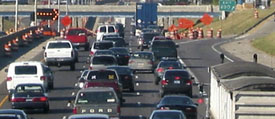Overview
The Work Zone Safety and Mobility Rule (Rule) was published on September 9, 2004 in the Federal Register. All state and local governments that receive federal-aid funding were required to comply with the provisions of the rule no later than October 12, 2007. The Rule updates and broadens the former regulation at 23 CFR 630 Subpart J to address more of the current issues affecting work zone safety and mobility. The changes to the regulation encourage the broader consideration of the safety and mobility impacts of work zones across project development and the implementation of strategies that help manage these impacts during project delivery.
- Final Rule Language – Final text of the Rule, as well as the notices of proposed rulemaking.
- Frequently Asked Questions – Questions and answers on the Rule.
- Guidance and Other Technical Resources – Guidance documents, brochures, factsheets, and toolboxes to assist with Rule implementation.
- Implementation Examples – What agencies are doing to implement the Rule.
- Informational Materials – Articles, presentations, and webinars about the Rule and implementation practices.
For information on the Temporary Traffic Control Devices Rule (Subpart K), visit the Regulation and Policy page.
The goals of the new rule are to:
- Expand thinking to address corridor, network, and regional issues while planning and designing road projects.
- Expand work zone impact mitigation beyond traffic safety and control by developing Transportation Management Plans (TMPs) for road projects. A TMP always consists of temporary traffic control strategies, and where necessary, it also consists of transportation operations and public information strategies.
- Advocate innovative thinking in work zone planning, design, and management, so as to consider alternative/innovative design, construction, contracting, and transportation management strategies.
 The new rule emphasizes partnership between the FHWA and the states. The rule was written to be flexible to allow states to apply the provisions as appropriate to their respective operating circumstances and to serve the needs of their different project types and classes. It is characterized by a policy-driven focus to institutionalize work zone processes and procedures, with specific provisions for application at the project level.
The new rule emphasizes partnership between the FHWA and the states. The rule was written to be flexible to allow states to apply the provisions as appropriate to their respective operating circumstances and to serve the needs of their different project types and classes. It is characterized by a policy-driven focus to institutionalize work zone processes and procedures, with specific provisions for application at the project level.The rule can be defined by three primary components:
- Policy-level provisions that help states implement an overall work zone safety and mobility policy for the systematic consideration and management of work zone impacts.
- State-level processes and procedures that help states implement and sustain their respective work zone policies.
- Project-level procedures that help states assess and manage the work zone impacts of individual projects.